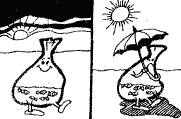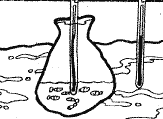


T he following guidelines apply in any case where seed fish are transported and stocked:
 |
 |
The earlier in the season that fish can be stocked, the longer the growing period. Also, the earlier in the rainy season, the fewer the predators.
However, fish cannot be stocked before there is water available and the farmer should be reasonably sure that the field will hold water for several months before he stocks. Rice should also be well-established with 2-3 tillers out before fingerlings or large fish are allowed into the field.
Finally, the farmer may be ready to stock but seedfish may not be available. Therefore, the family may have to wait until fish can be found.

There is no «best» formula here. Large fish are more expensive than small ones, but are better able to escape predation. Species can differ in price. Many fish cost more than few; the family's budget, then, can affect what is stocked.
For beginning farmers and for those who cannot feed their fish, stocking not more than 300 (5 cm) fish per 1 000 mē is suggested. A species ratio that commonly works in Thailand is common carp (Cyprinus carpio), silver barb (Barbodes gonionotus) and tilapia (Oreochromis niloticus) at 2:2:1.
This formula will not be appropriate in every case, but is as good a point of beginning as any. In general, it is better to culture two or more species than only one, since different kinds of fish eat different foods. This means total catch should be higher than if only one species is raised. The formula given can be modified for many reasons:
 |
1. Availability
A farmer may want a certain combination of species and sizes, but still has to be content with what he can find on the market.
2. Preference
Each family will have different species preferences, usually for valid reasons. These should be accepted. Similarly, many farmers prefer large seed because of their higher survival or greater final size. Others prefer small seed despite probable higher mortalities because of lower prices and higher continuity of harvesting; specific prices will affect the economics here. The family with limited budget must often decide between buying a few large fish or many small ones.
3. Species-specific biology
Fish species have differing advantages and disadvantages: Tilapia (O. niloticus) tolerates environmental extremes very well and reproduces easily. The farmers who can keep a few fish all year round need not worry about restocking every year. However, reproduction can lead to overcrowding and poor growth. Some farmers do not like the taste, find the fish ferments poorly and complain that it competes with or drives away other desirable species.
Common carp (C. carpio) tolerates poor water quality and shows excellent growth in most ricefields. However, probably due to high susceptibility to predation, survival of this fish is poor.
Silver barb (B. gonionotus) usually has excellent survival in ricefields; even fry tend to show good recovery. It is less tolerant of poor water quality than the two species above and does not grow well in very shallow water or one of highly unstable depth.
Various wild species, notably snakehead (Channa sp.) and walking catfish (Clarias sp.) are very palatable.
The snakeskin gourami (Trichogaster pectoralis) has shown very promising results in a few rainfed ricefields. Broodfish, not seed, should be stocked. More work should be done on this species under rainfed conditions.
Chinese and Indian major carp usually show poor growth in rainfed fields. In deeper water (50 cm or higher), they appear to do better. They should be stocked at low rates, no more than 200/ha.
4. The presence of several important predators can affect size and species stocked. Large fish escape predators easily, but this appears a less important consideration for silver barb than for other cultured species.

If stocking density is low, there is often sufficient natural food in the paddy and no feeding is necessary. |
If stocking density is increased, natural food in the paddy is not enough and production is low. |
If stocking density is increased, maximum production can still be obtained with supplementary feeding. |
5. Culture field will often affect number and species stocked. Occasionally, silver barb will not grow well in field with very shallow water (less than 10 cm). In small fields, the farmer may find the advisable number of fish limited by available area. On the other hand, there is nothing wrong with stocking few fish in a very large field, especially if this is all the farmer can afford.
6. The suggested rate of 3 000/ha can be increased if the field has stable water depth (30 cm or more is preferable) and if the field can be fertilized frequently. If fish are fed, the feed should be put in the field, not in the refuge. Otherwise, they will stay in the refuge, the rice will not benefit and the fish will become overcrowded. Farmers should be very cautious about stocking over 6 000/ha. This can work occasionally, but should be done only by experienced farmers who know their system. Small fry can be stocked in greater numbers than large fingerlings.
Issues for further consideration The case presented here depicts fingerling transport in oxygenated plastic bags, which are not widely used in poor rural areas, for example in Bangladesh and India. There, other delivery systems, such as in open containers, are used. The stocking rates and practices shown in the example imply that food fish are to be produced. On the other hand, ricefields can be used as nurseries for fry, the practice of which is well tuned to the short-growing duration of many rice varieties (e.g. 3-4 months). In such cases, the stocking densities would be considerably higher than the 3 000 fry/ha suggested above. Depending on local availability, other species combinations would be chosen. The roles of different species more suitable for ricefields should be considered. Surface feeders (e.g. silver barb) and bottom feeders (e.g. common carp) perform relatively better than column feeders (e.g. silver carp) in ricefields as compared to ponds. As a simple prophylactic measure that helps against infectious fish diseases, fish seed could be given a dip treatment for 1 minute in a 50 percent common salt solution, prepared on the spot at the site of stocking. |